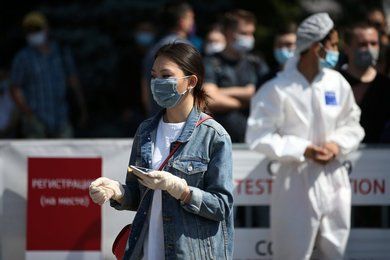Consequences of the COVID-19 Pandemic in Central Asia

The Pandemic
Central Asian countries have adopted different approaches to stopping COVID-19. Kazakhstan officially has 18,765 infections (as of June 24), Uzbekistan, 6,755, and Kyrgyzstan, 3,726, which recorded the first infections officially in March. They all introduced restrictions at the early stage of the pandemic and since May, despite a continuous increase in infections, began re-opening their economies. Tajikistan noted the first COVID-19 infections only on 30 April and the initial concealment of the development of the pandemic and the delayed reaction of the state led to a rapid increase in infections (currently 5,567). Turkmenistan still declares there has been no COVID-19 infection; however, unofficially, several hundred cases have been reported.
Economic Effects
The pandemic will lead to worsening economies and a lower standard of living in the region. This year, the World Bank predicts a GDP decline in Kazakhstan by 5.3%, in Kyrgyzstan by 4.1%, in Uzbekistan by 4%, in Tajikistan by 6.5%, and in Turkmenistan by 5%. Central Asia’s economic problems will deepen as Russia’s economy slows—the region’s countries are susceptible to changes in the Russian economy and their currencies to a falling rouble. Russian investments, the second-largest in the region (13%) after China (21%), will decrease. Regional raw material exporters—Kazakhstan (about 70% of export revenues) and Turkmenistan (about 90% of revenues)—will lose a large part of their budget revenues as a result of low oil and gas prices, as well as the economic slowdown in China, where about 60% gas exports from Central Asia go.
The economic slowdown in Russia and the accompanying rise in unemployment (to 30% since the beginning of the pandemic) will limit the scale of labour migration to that country in the short to medium term. Migrants from Central Asia working in Russia—often employed illegally or on flexible conditions for employers—numbered about 5 million before the pandemic, so many will lose their jobs and be forced to return home, which will translate into a decline in the total of foreign financial transfers to their countries of origin. These funds constituted an important source of income for the population, accounting for about 35% of GDP in Kyrgyzstan, 25% in Tajikistan, and 15% in Uzbekistan. Unemployment in the region will increase because the labour markets of Central Asian countries are not prepared for the return of their citizens and the Russian market will not be replaced by neighbouring China, Iran, or Turkey. Migration pressure on Kazakhstan, the richest country in the region, will increase, but that country also is affected by increased unemployment (about 1 million migrants from Central Asia already work there). Migration to the EU, where the number of labour migrants and political refugees coming from the region has increased in the last five years, will also rise, as will movement to the Gulf States.
Effects on Regional Security
The economic crisis will threaten the stability of Central Asia by intensifying anti-government protests and ethnic tensions already taking place on the Uzbek-Kyrgyz border and Tajik-Kyrgyz border in the Fergana Valley. The protests as usual will be pacified by the authorities, in part by using surveillance methods developed for the pandemic. This will affect the course of power succession in Kazakhstan or Tajikistan and weaken the internal position of governments that were late in reacting to the pandemic (Tajikistan and Turkmenistan).
Radicalisation amid financial and anti-government turmoil will strengthen as will the activity of terrorist organisations benefiting from Al-Qaeda support, such as the Uzbek Islamic Jihad Union, Katibat Imam al-Buchari, Katibat Tawhid wal Jihad, Tajik Jamaat Ansarullah, Uighur Islamic Turkestan Party, and regional cells of the so-called Islamic State (ISIS). These group’s recruitment activities will be directed primarily to migrants returning from Russia, like during the economic crisis in the region after 2014. That same year, more than 5,000 fighters from Central Asia took part in the fighting in Syria and Iraq on the ISIS side, and some of them were used to carry out attacks in Europe (e.g., in Istanbul, St. Petersburg, and Stockholm in 2017). Fighters from the region took part in the war in Ukraine on the Russian side and in Syria in the ranks of Russian private military companies (PMCs). ISIS primarily but also the Russian PMCs will also use recruitment channels created at that time.
Rivalry between Russia and China
Russia and the Eurasian Economic Union (EEAU, to which Kazakhstan and Kyrgyzstan belong), as well as the Collective Security Treaty Organization (CSTO, in which Tajikistan also participates), remain passive towards the pandemic in Central Asia, which weakens their influence in the region. Russia has limited itself to securing military facilities in Kazakhstan, Kyrgyzstan, and Tajikistan for use to counter the pandemic. The EEAU summit on 20 March revealed deepening divergences in the vision of integration development—Russia is interested in political integration, while the other members want to deepen economic integration. Russia does not consider their needs, including refusing EEAU members’ requests (e.g., Kyrgyzstan) to lower gas tariffs during the crisis and arguing in favour of delaying the introduction of common market rules in the raw materials sector.
Despite the pandemic, there has been a rise in anti-Chinese sentiment in Central Asia. However, China will retain economic influence in the region and its Belt and Road Initiative (BRI) will remain the main instrument. By taking advantage of the recession in Central Asian countries, China will offer them credit support in exchange for political influence. This applies especially to the poorest countries in the region, Kyrgyzstan and Tajikistan, as well as Turkmenistan, which is economically dependent on China. Along with the increase in terrorist and migration threats and the weakness of the region's countries, China will strive to strengthen its military involvement in the region, which will contribute to an increase in the Russo-Chinese rivalry in the security sphere. China is already developing bilateral military cooperation with the countries of the region under the framework of the Shanghai Cooperation Organisation (SCO) and has military bases in Tajikistan and Afghanistan, while Chinese PMCs operate in the region.
Perspectives
The COVID-19 pandemic will deepen the pauperisation of Central Asian societies as a result of the wide recession in the region and return of economic migrants from Russia. To counter the economic consequences of the pandemic, Central Asian countries will rely on the help of international institutions. The International Monetary Fund plans to allocate more than $2 billion to support the countries of the region. This assistance will be important for macroeconomic stabilisation but it will not stop the decline in the standard of living of the population. This will increase migration pressure from Central Asia on Europe and others and lead to a decrease in the stability of the region by intensifying anti-government protests, ethnic tensions, and the activities of terrorist organisations.
In response to the rise in instability in the region and the increased terrorist threat, a focus of China, which fears the presence of Uighur terrorist groups such as the Islamic Turkestan Party, the further development of Chinese military infrastructure in Central Asia and bilateral military cooperation with the countries of the region is possible. This will exacerbate the Russo-Chinese competition in the sphere of regional security, because despite its passivity towards the pandemic, Russia will strive to maintain its influence and advantage over China in this sphere. In response to China’s actions, Russia will strive to develop its own military infrastructure in Kyrgyzstan and Tajikistan and strengthen cooperation with Central Asian countries through the CSTO. Russia may cite as a reason enhanced cooperation under the CSTO in combating biological threats, with the possibility of using CSTO rapid-response forces, which in practice would allow it to interfere more in the internal situation of the region’s countries.
Terrorist organisations, especially ISIS, will seek to increase their influence in neighbouring Afghanistan and likely will try to use the region’s destabilisation to attract recruits to fight in the Middle East (including in Syria and Iraq, where ISIS aims to rebuild its power) or ISIS cells in Europe. The Russian PMCs will also make greater use of fighters from Central Asia in conflicts in Syria and Libya.


